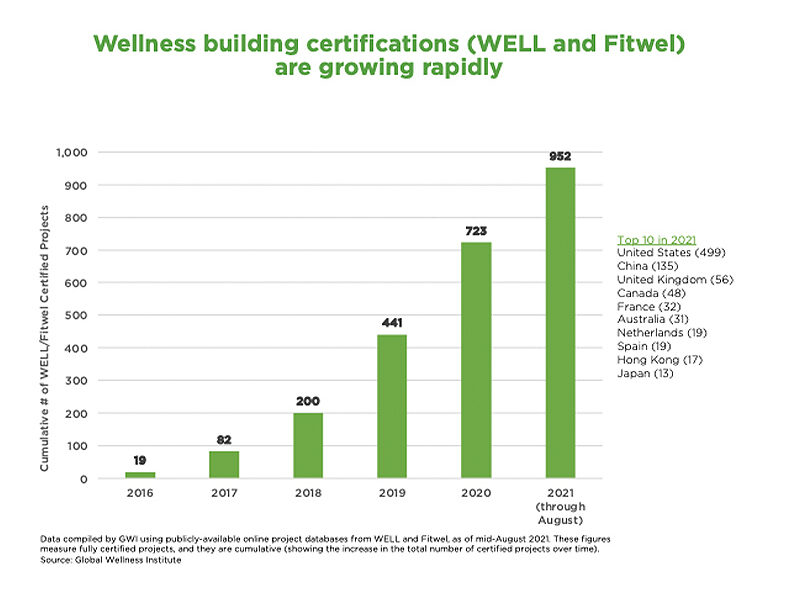
The Number of Wellness-Certified Buildings Explodes
One clear indication of the extraordinary rise of wellness real estate is the number of projects earning wellness building certifications in recent years. The GWI’s new report, Wellness Real Estate: Looking Beyond COVID-19, finds that the total number of wellness-certified building projects from the two big players, The Well Building Standard (WELL) and Fitwel, have grown ninefold in the last three years. As of August 2021, there were over 960 WELL and Fitwel certified projects globally–with another 1,431 projects in progress for certification (Fitwel) or pre-certified (WELL). During the pandemic, both organizations launched important new ratings standards to address disease transmission risks and an additional 7,684 properties earned those ratings.
One good way to understand the rapid growth trajectory of wellness real estate is to look at the number of projects earning wellness building certifications in recent years. The WELL Building Standard (WELL) and Fitwel are the two major third-party rating systems that focus specifically on health and wellness of building occupants. WELL awarded its first certifications in 2014, while Fitwel certified its first projects in 2016. As evident in the chart below, interest in wellness certifications has risen rapidly since that time, with the total number of wellness-certified Wellness Real Estate: Looking Beyond COVID-19 | 9 building projects increasing by nearly nine times from 2017 to 2020. As of August 2021, there building projects increasing by nearly nine times from 2017 to 2020. As of August 2021, there are over 950 WELL and Fitwel certified projects globally, with just over half of these located in the United States. The majority of these certifications are for office/commercial, hospitality, and retail properties, with about one-third in residential projects. As of August 2021, an additional 1,431 projects are in progress for certification (Fitwel) or pre-certified (WELL), with the majority of these located in the United States, China, Canada, Hong Kong, United Kingdom, and Australia. During the pandemic, both organizations launched new rating standards to address disease transmission risks (the WELL Health-Safety Rating for Facility Operations and Management, and the Fitwel Viral Response Module); an additional 7,684 properties have earned those ratings to date (primarily in the United States and Mexico).

It is important to keep in mind that WELL and Fitwel certifications represent only a fraction of the wellness real estate market as defined by GWI. For one, the impact of these rating systems extends far beyond the simple number of certifications awarded. For example, large, multi location companies are increasingly consulting with these rating systems to enhance healthy features across their entire portfolio of buildings, even though they may only officially certify their headquarters. Although WELL and Fitwel are the most well-known and most global programs, a wide range of other wellness-related certifications and toolkits are available in the market, many of which focus more broadly on sustainability or regenerative living rather than just wellness (e.g., Living Building Challenge, One Planet Living). In recent years, well-established green building certifications like LEED and BREEAM have been shifting toward a more holistic emphasis on human health and have added criteria related to indoor environments and occupant health and well-being. Early in the pandemic, the U.S. Green Building Council announced a new vision and strategy – “Healthy people in healthy places equals a healthy economy” – aiming to position LEED as a platform for post-COVID recovery and healthier communities. In Japan, the government has worked with the Institute for Building Environment and Energy Conservation (IBEC) to develop a health and wellness certification for offices as part of the country’s CASBEE certification system. The first project evaluations took place in 2019, and 43 properties have been certified to date.
























































